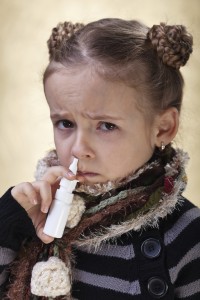A study published in the April, 2014 print edition of the journal Pediatrics found that September is the worst month for asthma attacks for children who suffer from the condition.
Researchers at Tel Aviv University in Israel did a retrospective, population-based study where medical records for a period of five years were reviewed, for more than 900,000 children between the ages of 2 and 15. These children had all received primary medical care between 2005 and 2009; close to 9 percent had been diagnosed with asthma by a physician. About half of the asthmatic children were between 2 and 5; just under one-quarter were between 6 and 9, and just more than one-quarter were between 10 and 15.
The study found that the month of September, when children returned to school, was also the month with the highest incidence of asthma flare-ups, as well as the most prescriptions written by doctors for all types of asthma inhalers. For the 37th and 38th weeks of the year — that is, early to mid-September, when children return to school — visits to the doctor for asthma conditions doubled, compared to the preceding weeks of late August to beginning of September. Rises in asthma-related doctor visits were also seen at the end of fall, and intermittently throughout the winter.
For the children in the study, fewer prescriptions for asthma inhalers had been filled in the summer months than during the rest of the year, so, researchers theorize that use of asthma maintenance medication was at its lowest just before the start of school. That could partly explain the increase in asthma flare-ups at the beginning of the school year, with the greater exposure to germs that naturally occurs when many children come together, and with the colds that children may get from that (viral infections are a known trigger for asthma attacks). Other possible triggers would be autumn allergens, to which children will be more exposed going to and from school, increased exposure to exhaust fumes and smog (other known asthma triggers), and the increased stress from going back to school (emotional stress is also an asthma trigger).
Asthma is a chronic disease of the airways, in which triggers can cause the bronchial tubes that carry air to the lungs to constrict, making breathing difficult or impossible. Triggers can also cause inflammation of the airways and the lungs (and excessive production of mucus), causing breathing to become labored or impossible.
Diagnoses of childhood asthma have increased at a fast pace in the last three decades; more than one in ten American children now have asthma. Increases in asthma cases are also occurring globally, with more than 300 million people suffering from asthma worldwide.
Health researchers at a number of universities and other institutions in the U.S. and abroad continue working to unravel the causes for the increase in incidences of asthma.
At one time, some medical professionals believed that our modern world had become too clean; the thinking was that children were not being exposed to enough infectious agents like viruses and bacteria, which would help train the children’s immune systems to develop defenses against different pathogens. But subsequent studies showed that even in places where many children are raised in more unsanitary environments, such as Latin America, cases of asthma are soaring, as well. Viral infections, including the common cold and flu, were believed not long ago to protect children from subsequently developing asthma. However, researchers now know that viral infections in early life can actually be a risk factor for getting asthma later on.
Other known asthma triggers include: dust, pollens, mold, smoke, cold weather, exercise (especially in cold weather), pet dander (from hair, skin or feathers) or saliva, strong chemical odors or fumes, perfumes or other scented products.
In the Israeli study, lead author Dr. Herman Avner Cohen, MD, suggested that for certain asthmatic children, it may be a good idea to start asthma treatments at the end of August, in preparation for the school year.
Current asthma prescription inhaler medications differ in strength and possible danger from long-term use. Some contain steroids, while others do not. Talk to your child’s pediatrician about using less-potent, but safer, non-steroid medications. In addition, many children may be safe using their inhalers only in cases of asthma attacks; ask your child’s doctor for an evaluation of your child’s individual case.
Also discuss with your doctor using natural methods to lessen or even end asthma symptoms, such as modifying the child’s diet to include healthier foods and avoid known allergens for that child. Essential plant oils are also being successfully used by many parents to naturally open and soothe their children’s airways as maintenance, when child is not having an asthma attack (get your doctor’s okay before using essential oils on your child). Relocating the family to a different area or climate may be an option for some parents. Home-schooling may be another option.
By Jamells Andrews NP, PA
